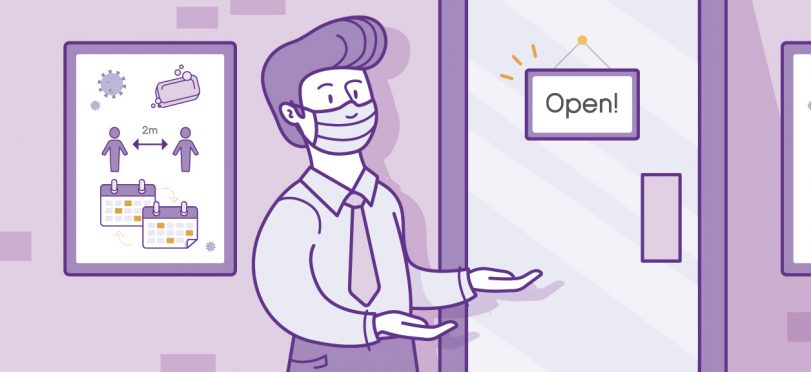5 Actionable Ways to Make Employees Feel Safe Returning Back to Work

With a majority of businesses slowly reopening in Canada and the US, the COVID-19 crisis has left many employees in fear of returning back to work.
Otherwise known as “re-entry anxiety”, the drastic shift from isolating for several months to re-entering the workforce while the virus still lingers on is no easy feat.
With fear turning on the fight or flight response, many employees are choosing the latter and for good reason: exposing the virus to their vulnerable loved ones can lead to tragic outcomes.
According to a recent Gallup poll, 6 out of 10 employees are very or somewhat worried that they or someone in their family will be exposed to the virus.
The big question remains: As leaders, how do you instill reassurance in your workplace when a silent virus is sweeping the nation?
While handing out masks and putting up sanitation stations in place are vital safety measures, it’s not enough to ensure the health and well being of your employees.
Fear is an emotional driver and manifests itself differently from person to person.
As much as you can’t entirely manage your employee’s fear, you can support them through it.
We spoke with our U.S. sales director Nicole, who reached out to various leaders in different industries and shared some actionable insights on making employees feel less anxious going back to work.
Here’s how:
1. Establish the “Why” Behind Each Safety Protocol
Whether you’re busy managing your workforce, ensuring safety protocols are met and put in place, you should never lose sight of your key focus: your employee’s emotional well-being.
Let’s face it, a fearful employee is an unproductive one. Employees are the core drivers of your business, without them your business wouldn’t be up and running in the first place.
How do you prioritize their emotional well-being amid the chaos of everything going on in between?
One way is by establishing the “why” behind each safety protocol.
Rather than inducing fear by instructing them to follow a whole new set of safety protocols tailored in your industry, giving them the backstory behind each action will make them feel more secure in their workplace.
Additionally, it’ll provide them with the right information to share when customers ask about specific protocols.
Whether it be implementing temperature checks or offering longer breaks in between shifts so they’re given the proper amount of time to wash their hands, educating them and getting into the “why” goes a long way in building their confidence.
After all, knowledge is power.
2. Make Transparency Your Best Policy
Whether it be sharing company updates or hearing an employee out on their personal concerns, now’s not the time to shy away from addressing difficult topics that are on most employee’s minds.
Aside from having the optimal safety measures in place, what an employee needs the most from you right now is to be “predictable during an unpredictable time”.
One way of bringing predictability in the workplace is by being transparent through keeping the lines of communication open.
As much as you may not have all the answers, by regularly communicating your company’s progress, updates on safety policies and the accomplishments made during this difficult time will make employees feel there’s hope at the end of the tunnel.
When in-person meetings aren’t a viable option or need to be scheduled at a later date, you can keep everyone up to speed by having a virtual town hall meeting to address health or concerns over job security, employees can work wonders in putting everyone’s minds at ease.
If you’d like to privately check-in with specific employees to see how they’re doing but want to save time scrolling through your phone contacts, you can easily streamline and keep track of all your employee conversations under your Voilà! scheduling app.
Despite time not always being on your side, ensuring the feedback loop is still in place goes a long way in showing you’re prioritizing your employee’s emotional needs.
According to Maslow’s hierarchy of needs, a safe work environment and addressing job security goes a long way in meeting the core fundamental physiological and safety needs of employees. Source:https://www.simplypsychology.org/maslow.html
By putting your employee’s emotional needs on the front lines (pun intended), you’re bringing back the core essentials in the workplace: stability and security.
3. Embrace in Co-Horting
Otherwise known as “squad scheduling”, co-horting involves limiting the spread of COVID-19 within your workforce by having the same employees work the same shifts. In other words: splitting up workers into groups to avoid cross-contamination from taking place. They only remain in contact with one another.
By having your employees work rotating schedules, if one happens to get infected by the virus, the entire group goes into quarantine. Not only does this prevent mass spreading from taking place but it also ensures the safety and well-being of your entire workforce.
In order for this COVID-19 method to go into full effect and be successful, you need to ensure cross-training takes place among your entire workforce.
Once the training is in place, you can easily keep track and customize which employees to put on rotating shifts using a workforce employee scheduling platform like Voila!.
That way, if one group of employees go in quarantine, you can quickly and easily schedule another group to take over their shifts without the hassle of using manual spreadsheets.
4. Emphasize the Importance of Community Safety
It’s one thing to impose new safety measures and rules for employees to follow, it’s another when you aren’t walking the talk or better yet, having other employees taking a laissez-faire approach to them.
Which is why it’s important that management creates training materials and clearly communicates them to all employees.
After all, the only way employees are going to truly feel safe is by highlighting how their actions (or lack of) impact not just their health but the entire communities as well.
Ensuring the agreed-upon procedures are followed by everyone will go a long way in providing safety to your employees.
5. Adapt Your Workforce to “Flexible Self-Scheduling”
Let’s face it: With COVID-19 shutting down in-person operations for non-essential businesses around the globe for several months, working from home has become the new norm for most.
With the exception of several hourly workforces that were shut down and have only recently begun to reopen including retail and restaurants as well as the manufacturing industry.
Amid the uncertainty, the economical aftermath the pandemic has left behind forced many businesses’ to re-adjust and re-think their way of running their business. All while leaving employees the need for a flexible work/life balance.
Coined as the future of work, self-scheduling is a method that’s been steadily adopted in many businesses including the technology and AI industries.
It involves letting managers define their scheduling needs based on their workforce demands all while empowering employees to swap, request or select their own shifts.
From reducing labour costs to increasing employee engagement and improving overall work/life balance, self-scheduling has shown to have positive effects in the workplace.
While certain jobs in industries such as in manufacturing and retail require employees to be physically present, the context created an opportunity for leaders everywhere to examine policies to determine if they can incorporate flexibility overall.
For example, in the manufacturing industry, “flextime” is one way in which employees receive the work/life balance they need.
By arranging with their managers to move up to two hours at the end of their previous shifts or the beginning of the following shift, this type of flexibility allows employees to enjoy a healthy work-life balance and take part in extracurricular activities or hobbies outside their workplace.
Whichever industry you’re in, when it comes to flexibility, there isn’t a one size fits all. Being open to adopting a flexible self-scheduling model that caters to your business will save you time managing schedules and give employees the optimal work/life balance they need to succeed.
Win/Win? Yes, please!


